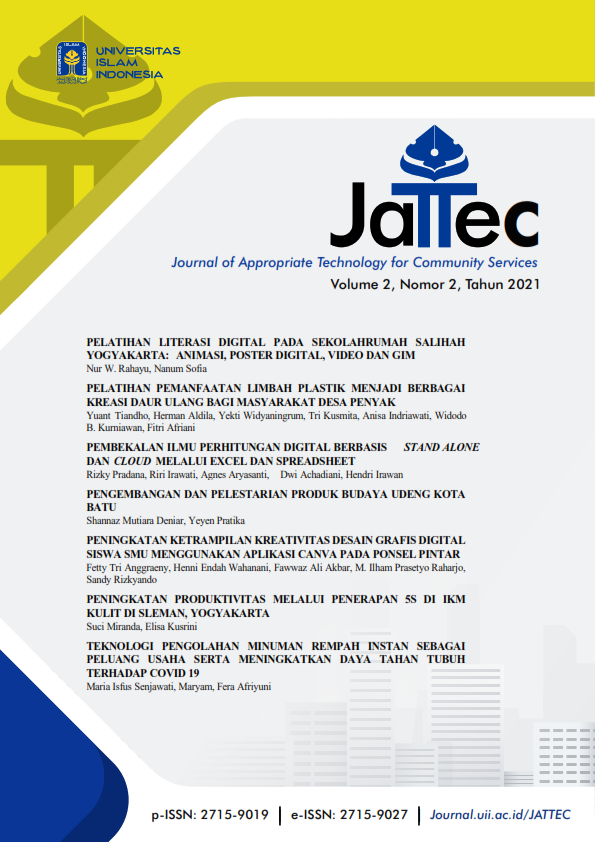Main Article Content
Abstract
As an archipelago, handling plastic waste in the Province of Bangka Belitung Islands is an aspect that needs to be taken seriously. Apart from being focused on developing tourist areas, plastic waste will easily be carried to the sea and prone to be degraded into microplastics, often consumed by marine animals. This community service activity focuses on Penyak Village, Kec. Koba, Kab. Central Bangka, Bangka Belitung Islands. To solve the plastic problem in that location, the community service team conducted training for the community, especially for Pendidikan Kesejahteraan Keluarga (PKK) members, related to processing plastic waste into various recycled creations such as bags, pencil cases, and different kinds of souvenirs. The training program is carried out by providing materials and direct training to increase the understanding and skills. To broaden people's insights, the team conducted training with the Ecoplantstic start-up, which focuses on developing waste-based products. Through the evaluation, it is known that the training provided can improve the knowledge and skills of the community in processing plastic waste into various recycled creations, and several participants plan to develop the skills acquired for entrepreneurial purposes.
Article Details
References
- Afriani, F., Widyaningrum, Y., Kurniawan, W., Aldila, H., & Tiandho, Y. (2020). Sosialiasi teknik penyimpanan produk hasil tangkapan laut dengan metode beku di Desa Penyak. Journal of Appropriate Technology for Community Services, 1(2), 113-118.
- Arico, Z., & Jayanthi, S. (2017). Pengolahan limbah plastik menjadi produk kreatif sebagai peningkatan ekonomi masyarakat pesisir. MARTABE: Jurnal Pengabdian Masyarakat, 1(1), 1-6.
- Chamas, A., Moon, H., Zheng, J., Qiu, Y., Tabassum, T., Jang, J., . . . Suh, S. (2020). Degradation rates of plastic in the environment. ACS Sustainable Chemistry & Engineering, 8(9), 3494-3511.
- Gusa, R. F., Sari, D. N., Afriani, F., Sunanda, W., & Tiandho, Y. (2020). Effect of electrode numbers in electrocoagulation of Batik Cual wastewater: analysis on water quality and energy used. IOP Conference Series: Earth and Environmental Science , 599, 012061.
- Kanti, M., Mukhirah, & Dewi, R. (2020). Kreasi kerajinan daur ulang limbah plastik. Jurnal Ilmiah Mahasiswa Pendidikan Kesejahteraan Keluarga, 5(4), 31-44.
- Nadlifatin, R. (2018). Pengolahan limbah plastik menjadi produk kerajinan tangan untuk meningkatkan ekonomi masyarakat Sendang Dajah. Jurnal Abdikarya: Jurnal Karya Pengabdian Dosen dan Mahasiswa, 1(1), 98-102.
- Nasution, R. (2015). Berbagai cara penanggulangan limbah plastik. Elkawnie: Journal of Islamic Science and Technology, 1, 97-104.
- Prihatmoyo, P., Dermawan, D., & & Bisono, F. (2018). Rancang bangun mesin destilator pengubah limbah plastik menjadi minyak. Proceedings Conference on Design Manufacture Engineering and its Application, 2(1), 105-110.
- Putra, H. P. & Yurindala, Y. (2010). Studi pemanfaatan sampah plastik menjadi produk dan jasa kreatif. Jurnal Sains dan Teknologi Lingkungan, 2(1), 21-31.
- Sandi, Nurdandi, D., & Tiandho, Y. (2019). Pengaruh jarak antar plat dalam penjernihan limbah batik cual dengan metode elektrokoagulasi. Prosiding Seminar Nasional Penelitian dan Pengabdian pada Masyarakat, 3(1), 12-14.
- Setyawan, Y. M., Putro, G. P., Santosa, A. B., & Fajar, M. (2020). Pemilihan mekanisme pencetak pada mesin pengolah limbah plastik menjadi paving block. IMDec, 2, 313-318.
- Smith, M., Love, D., Rochman, C., & Neff, R. (2018). Microplastics in seafood and the implications for human health. Current Environmental Health Reports, 5(3), 375-386.
- Sujithira, R., & Velmurugan, P. (2020). Microplastics in seafood-A tenet of hazard. Biotica Research Today, 2(7), 635-637.
References
Afriani, F., Widyaningrum, Y., Kurniawan, W., Aldila, H., & Tiandho, Y. (2020). Sosialiasi teknik penyimpanan produk hasil tangkapan laut dengan metode beku di Desa Penyak. Journal of Appropriate Technology for Community Services, 1(2), 113-118.
Arico, Z., & Jayanthi, S. (2017). Pengolahan limbah plastik menjadi produk kreatif sebagai peningkatan ekonomi masyarakat pesisir. MARTABE: Jurnal Pengabdian Masyarakat, 1(1), 1-6.
Chamas, A., Moon, H., Zheng, J., Qiu, Y., Tabassum, T., Jang, J., . . . Suh, S. (2020). Degradation rates of plastic in the environment. ACS Sustainable Chemistry & Engineering, 8(9), 3494-3511.
Gusa, R. F., Sari, D. N., Afriani, F., Sunanda, W., & Tiandho, Y. (2020). Effect of electrode numbers in electrocoagulation of Batik Cual wastewater: analysis on water quality and energy used. IOP Conference Series: Earth and Environmental Science , 599, 012061.
Kanti, M., Mukhirah, & Dewi, R. (2020). Kreasi kerajinan daur ulang limbah plastik. Jurnal Ilmiah Mahasiswa Pendidikan Kesejahteraan Keluarga, 5(4), 31-44.
Nadlifatin, R. (2018). Pengolahan limbah plastik menjadi produk kerajinan tangan untuk meningkatkan ekonomi masyarakat Sendang Dajah. Jurnal Abdikarya: Jurnal Karya Pengabdian Dosen dan Mahasiswa, 1(1), 98-102.
Nasution, R. (2015). Berbagai cara penanggulangan limbah plastik. Elkawnie: Journal of Islamic Science and Technology, 1, 97-104.
Prihatmoyo, P., Dermawan, D., & & Bisono, F. (2018). Rancang bangun mesin destilator pengubah limbah plastik menjadi minyak. Proceedings Conference on Design Manufacture Engineering and its Application, 2(1), 105-110.
Putra, H. P. & Yurindala, Y. (2010). Studi pemanfaatan sampah plastik menjadi produk dan jasa kreatif. Jurnal Sains dan Teknologi Lingkungan, 2(1), 21-31.
Sandi, Nurdandi, D., & Tiandho, Y. (2019). Pengaruh jarak antar plat dalam penjernihan limbah batik cual dengan metode elektrokoagulasi. Prosiding Seminar Nasional Penelitian dan Pengabdian pada Masyarakat, 3(1), 12-14.
Setyawan, Y. M., Putro, G. P., Santosa, A. B., & Fajar, M. (2020). Pemilihan mekanisme pencetak pada mesin pengolah limbah plastik menjadi paving block. IMDec, 2, 313-318.
Smith, M., Love, D., Rochman, C., & Neff, R. (2018). Microplastics in seafood and the implications for human health. Current Environmental Health Reports, 5(3), 375-386.
Sujithira, R., & Velmurugan, P. (2020). Microplastics in seafood-A tenet of hazard. Biotica Research Today, 2(7), 635-637.

